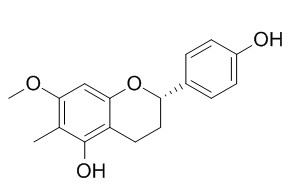2H-1-Benzopyran-5-ol
Reference standards.
Inquire / Order:
manager@chemfaces.com
Technical Inquiries:
service@chemfaces.com
Tel:
+86-27-84237783
Fax:
+86-27-84254680
Address:
1 Building, No. 83, CheCheng Rd., Wuhan Economic and Technological Development Zone, Wuhan, Hubei 430056, PRC
Providing storage is as stated on the product vial and the vial is kept tightly sealed, the product can be stored for up to
24 months(2-8C).
Wherever possible, you should prepare and use solutions on the same day. However, if you need to make up stock solutions in advance, we recommend that you store the solution as aliquots in tightly sealed vials at -20C. Generally, these will be useable for up to two weeks. Before use, and prior to opening the vial we recommend that you allow your product to equilibrate to room temperature for at least 1 hour.
Need more advice on solubility, usage and handling? Please email to: service@chemfaces.com
The packaging of the product may have turned upside down during transportation, resulting in the natural compounds adhering to the neck or cap of the vial. take the vial out of its packaging and gently shake to let the compounds fall to the bottom of the vial. for liquid products, centrifuge at 200-500 RPM to gather the liquid at the bottom of the vial. try to avoid loss or contamination during handling.
RSC Adv.2023, 13(9):6317-6326.
BMC Pharmacol Toxicol.2018, 19(1):5
Int J Mol Sci.2024, 25(18):10219.
Evid Based Complement Alternat Med.2017, 2017:1401279
Int J Mol Sci.2021, 22(12):6466.
Integr Cancer Ther.2018, 17(3):832-843
Biomolecules.2021, 11(10):1537.
The Catharanthus Genome2022,35-83.
Environ Toxicol.2021, 36(9):1848-1856.
Food Chem.2019, 278:683-691
Related and Featured Products
Journal of Asian Natural Products Research, 2017, 21(2):1-7.
Two new metabolites from Daldinia eschscholtzii, an endophytic fungus derived from Pogostemon cablin.[Reference:
WebLink]
METHODS AND RESULTS:
The chemical investigation of the mycelia of endophytic fungus Daldinia eschscholtzii A630, which was isolated from the medicinal plant Pogostemon cablin, resulted in the isolation of two new compounds, named eschscholin A (1), 3-ene-2-methyl-2H-1-Benzopyran-5-ol (2), and one new natural product 3,5-dihydroxy-2-methyl-4H-chromen-4-one (3), along with seven known compounds. Their structures were fully characterized by means of detailed spectroscopic analysis, and in comparison with published data for known compounds.
CONCLUSIONS:
All of the isolated compounds (1-10) were evaluated for their antibacterial activities.



